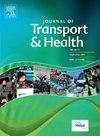Does walking for transport contribute to the longitudinal association between neighbourhood walkability and body mass index among mid-to older-aged Australian adults?
IF 3.2
3区 工程技术
Q2 PUBLIC, ENVIRONMENTAL & OCCUPATIONAL HEALTH
引用次数: 0
Abstract
Introduction
Studies examining the associations between neighbourhood walkability and adult body weight, as well as the potential mediating role of walking for transport (WfT), are mainly cross-sectional, and longitudinal evidence is lacking. This study investigated the longitudinal association between walkability and body mass index (BMI) and assessed the contribution of WfT to this association.
Methods
Data from the HABITAT multilevel longitudinal (2007–16) study of 11,035 middle-aged adult residents of 200 neighbourhoods in Brisbane, Australia, were used. Neighbourhood walkability within a 1 km network buffer around residents’ homes was objectively measured using land use mix, street connectivity, and residential density, and BMI was measured using self-reported height and weight. At each wave (2007, 2009, 2011, 2013 and 2016), respondents estimated the duration (minutes) of WfT in the previous 7 days, which was modelled as both a binary and continuous measure. Mixed-effects regression models were used to examine whether any WfT (yes/no) contributed to the association between walkability and BMI, and generalised structural equation modelling was used to estimate the mediating effect of minutes WfT on this relationship. The models were adjusted for age, sex, education, occupation, household income, neighbourhood disadvantage, survey year, and residential self-selection.
Results
Living in a walkable neighbourhood was significantly associated with greater odds of engaging in any WfT and more minutes of walking, and each measure of walking was associated with a lower BMI. Any WfT made no apparent contribution to the association between walkability and BMI, whereas minutes spent walking explained approximately 7.8 % of this relationship.
Conclusions
Walkable neighbourhoods may help reduce BMI at the population and individual levels by promoting WfT. Creating walkable communities to support WfT holds the potential for maintaining a healthy body weight and preventing the onset of weight-related chronic conditions such as diabetes and cardiovascular disease.
在澳大利亚中老年成年人中,以步行为交通工具是否有助于社区步行性与体重指数之间的纵向关联?
研究邻里步行性与成人体重之间的关系,以及步行交通(WfT)的潜在中介作用,主要是横断面的,缺乏纵向证据。本研究调查了步行能力与身体质量指数(BMI)之间的纵向关联,并评估了WfT对这种关联的贡献。方法采用澳大利亚布里斯班市200个社区11,035名中年居民的生境多层次纵向研究(2007 - 2016)数据。通过土地利用组合、街道连通性和居住密度客观地测量了居民住宅周围1公里网络缓冲区内的邻里步行能力,并通过自我报告的身高和体重测量了BMI。在每一波(2007年、2009年、2011年、2013年和2016年)中,受访者估计了前7天WfT的持续时间(分钟),这是二元和连续测量的模型。使用混合效应回归模型来检验是否有任何WfT(是/否)有助于步行性和BMI之间的关联,并使用广义结构方程模型来估计分钟WfT对这种关系的中介作用。模型根据年龄、性别、教育程度、职业、家庭收入、邻里劣势、调查年份和居民自选进行了调整。结果:生活在适宜步行的社区中,参加任何形式的运动的几率都更高,步行的时间也更长,而且每一项步行的测量都与较低的BMI有关。步行时间对步行能力和BMI之间的关系没有明显的影响,而步行时间对这一关系的解释约为7.8%。结论可食性社区可能通过促进WfT在人群和个体水平上降低BMI。创建适合步行的社区以支持WfT,有可能保持健康的体重,并预防与体重相关的慢性疾病(如糖尿病和心血管疾病)的发作。
本文章由计算机程序翻译,如有差异,请以英文原文为准。
求助全文
约1分钟内获得全文
求助全文

 求助内容:
求助内容: 应助结果提醒方式:
应助结果提醒方式:


